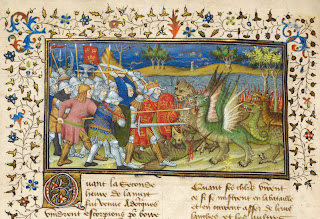I haven't posted a review of an exhibition before - I may not do so again. Who knows? Anyway, my partner and I visited the British Library's current exhibition 'Royal Manuscripts: The Genius of Illumination' (details here) and, yeah, it was OK.
It was OK in the way that having to eat a huge, rich slice of chocolate cake is OK. By which I mean an enormous slice of rich, dark (80% cocoa) chocolate-iced, dark chocolate fondant-centred chocolate cake. With added chocolate. In other words, there is a lot of beautiful material here, but it is there in unrelieved saminess, unimaginatively laid out side by side in glass vitrines all essentially arranged identically with, usually, three books open at a particular page. In small measures, better presented it would have been gorgeous but set out like that and in that quantity it was really all too much for one sitting. My advice would be, if you're thinking of going, to put 27 quid aside and go three times to see a third of it at a time.
The manuscripts involved are from the royal collection and the narrative, insofar as there is a discernible narrative, is about the relationship between texts and monarchy. The fact seems curiously skipped over that many of the manuscripts in the exhibition only entered royal possession many years (centuries sometimes) after they were produced (acquired, for instance, by James I's eldest son Henry, Prince of Wales, or by Charles II).
Why these books were collected by the figures involved seemed to me to be a more interesting issue than you'd have imagined. All the key figures involved (Edward IV, Henry VII/VIII, Henry Stuart, Prince of Wales, Charles II) feature at the start of new dynasties or after a royal crisis/interregnum. The collection of books of English history by Welsh (Tudor) and Scottish (Stuart) royals also seemed to be worthy of interest. Another point that didn't seem to get much attention was the linguistic politics involved. The vernacular features in certain types of Anglo-Saxon text (and in particular places - an issue not really dealt with) but after the Conquest almost all the texts are in French until the late Middle Ages, although one of the most impressive, with large numbers of appended seals, was in English.
The captions weren't uniformly helpful, or always accurate. The perspective, throughout, was art historical rather than literary or historical. I was startled to see a figure in the Bedford Hours (of which there is a very nice interactive display near the end) described as 'an emperor' 'curiously' wearing the arms of France impaled with those of the Empire. Not so curious if you think he might be Charlemagne, though, surely? He's wearing Charlemagne's crown after all. A juxtaposition of music and troubadour lyric was described as 'unique'. It isn't. The Romance of the Rose was described as being a useful guide to conduct for a prince (this was generally the catch-all explanation for just about every kind of text), suggesting that the caption writer hadn't read the Romance of the Rose, or at least didn't know much about it beyond its stated purpose (handy Wikipedia entry here). It would be pretty difficult to use this text as any sort of guide to royal conduct. Apparently the accompanying exhibition book (very handsome and reasonably priced at £25) is rather better.
But there is some great stuff here, including a number of well-known late Anglo-Saxon manuscripts, a lavishly illustrated fifth-century Genesis that just barely escaped the Cotton fire of 1731, route-maps to the Holy Land, great drawings of elephants (any medieval drawing of an elephant is worth going to see in my, er, book) and, as they say, 'many more'. If you know what you want to see and do some reading before hand you could get an awful lot out of this exhibition, but I'm not sure I'd advise it as something to try and devour all at once. Otherwise you'll probably miss or otherwise fail to appreciate some of its gems - such as a young Elizabeth I's Latin letter to her father, tucked away to one side. And there are a lot of gems here.
